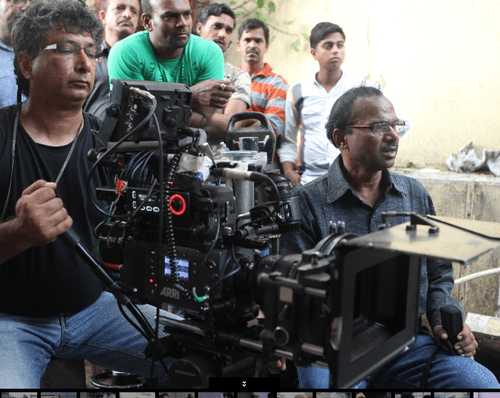Bollywood News
Bollywood/TV Shooting Likely To Resume In June, Maharashtra Government Issues Detailed Guidelines

Shooting is expected to resume in the Mumbai studios from the first week of June. Maharashtra government on Sunday announced film and television shooting could resume in non-containment zones as a part of the relaxations that the state would undergo in June.
Maharashtra’s Cultural Affairs department said that producers will have to conduct pre-production and post-production by adhering to the guidelines laid down by the government.
The Maharashtra government issued a detailed guideline for the Mumbai entertainment industry to follow. The entire text of the guidelines is given below:
Annexure – A (IRT Fury 9.91f97–2020 / 7.55.36/1..9, fè.30.04.2020 at 16431)
Guiding Principles To restart Media Entertainment Industry in Maharashtra
- A) Managing Covid-19 Risks on the Set / Studio and Edit facilities
Educating and empowering partners and employees
Educating and sensitising all partners, employees on preventive measures will continue to be the topmost priority. Already, organisations have educated and sensitised employees and partners about this. Further, multiple sessions will be scheduled from a certified health and safety consultant to educate all stakeholders at various locations. Following would be addressed in the session:
- Awareness about the novel corona virus,
Precautions
- Symptoms & stages of infection
- Tests (for symptomatic employee) & tests centres around your areas
- Promote regular hand washing, sanitisation and contamination control
- Promote good respiratory hygiene
- B) PRODUCTION OFFICE / TRAILER / TENTS
- Consider utilizing larger tents with portable A/C or heat in lieu of trailers /
motorhomes wherever possible.
- Avoid having more than 5 people in trailers at one time.
Keep windows and doors open to increase ventilation. Deliveries should be handle outside of an office or any closed space and wiped down / sprayed with sanitizing solution. When possible use disposable, ecologically friendly flatware, plates and cups.
Place sanitizing wipes at printer station if there is a community printer / copier.
- Continuously disinfect remote controls, light switches, etc.
lawa)
Scanned with CamScanner
- C) Studio Premises including Sets
Crowd Control On any Set location, exists Artists (main cast) and the crew which includes Technicians, workers and junior artists. The number of artists in main cast can not be reduced.
Minimize Crew strength to 33% of pre-COVID (not including main cast) crew strength. Identify which all activities can be executed remotely i.e. over video conferencing, email, video sharing etc. Similar exercise to be carried out for film’s shoot as well. This crew number does not include security personnel, drivers, catering service and generator operator. All staff members carry identification (ID) card while travelling for shoot. While seeking the permission from Government for travel, necessary permissions to be given by the Government authorities to enable the employees to reach their destination.
Aarogya Setu app to be installed on compatible devices and to be kept on throughout the day
Precautionary guidelines / signages to be displayed in strategic locations with emergency helpline number
Floor markings at gates and appropriate places with social distancing norms
Designated people shall be allowed to open doors, gates etc.
Ambulance, doctor and nurse compulsory on every set.
Every producer should provide minimum 3 washroom and same to be sanitized every hour.
Training of housekeeping staff will be done on regular basis. Any person found COVID +ve during the shoots or during his travel for shoots should be mandatorily given treatment.
Medical personnel should take temperatures / check medical credentials /
approvals.
Medical personnel should visually monitor cast and crew for those that look ill. Before entering the premises, check people for mild cough or low-grade fever using infrared thermometer (37.3 degree Celsius or more) and accordingly scanned with CamScanner
isolate or advise them to stay at home. In addition to this, every set shall have pulse Oximeter that measures oxygen saturation level in our body. All cases with symptoms of influenza like illness, Severe acute Respiratory Distress, fever, cough or similar symptoms shall be reported to nearest Local Authority / Collector.
Signed declarations should capture their name, age, contact details, blood group, in case of any ailments like diabetes, hypertension, cardiac issues, etc. Every unit should maintain co-morbid data.
Any pregnant employee or if an employee has their spouse pregnant, they shall not be allowed on the set till further orders.
Any cast / crew members above the age of 65 years will be not be allowed at the site.
For fiction / non-fiction, NO audience should not be allowed.
Daily fumigation of all Sets and Post-Production set-ups including edit rooms
Regular cleaning schedule for sets, washrooms and makeup rooms, ensure timely toilet sanitation.
Practice of wearing masks and face-shields to be made compulsory and hand sanitisers to be given to crew members. Strictly no guests, whosoever, be allowed at the shoots / sets.
Eliminate “open calls” and give everyone assigned time window to arrive on set.
Members of each department should disinfect gear during breaks. Strive for consistency regarding which pieces of (Camera/printers/laptops/mics/etc) are handled by whom.
equipment
- When possible, castings should be done remotely via Facetime, Zoom, Skype,
etc. 2. Utilize remote casting sessions and call backs with live broadcast capabilities. 3. Schedule auditions and call backs further apart and require social distancing. 4. If distributing hard copy scripts / sides, dispose of paper after each reading. 5. Eliminate “open calls” and give everyone assigned window to arrive. 6. Encourage actors to wait in their cars, not in the waiting area of the casting facility. 7. Have actors check in from outside using their cell phone. 8. One dedicated Casting Assistant should sign all performers in and out. 9. During in-person group auditions, actors can wear clear face shields and glove,
or maintain social distancing. 10. When casting of families, real families should be used when possible so physical contact is kept within an existing family unit. 11. Identify wardrobe specs in the breakdowns to increase the likelihood the actor
brings something that can be worn on the shoot.
HANDLING OF EQUIPMENT
- Members of each department should disinfect gear during breaks in activity. 2. Minimize the number of people having to touch the same items. This may
require additional gear. 3. Strive for consistency regarding which pieces of equipment are handled by
whom. 4. All crew that requires tools should bring their own and not allow sharing.
- F) Operational Controls
- The shooting shall be held in a completely locked down environment and
adhering to the Government instructions and rules.
- It will be in the gated and secured premises with 24/7 security
- Ensure minimal physical contact
- Crew members will be instructed to maintain minimum distance of 6 feet from
each other while performing various activities
- Masks shall to be worn by all the crew members and other support staff in the
premises. Gloves shall be optional.
- All door and gates to be manned by security guard(s) to open and close the
doors, in order to minimise touching of the doors/ handles
- Dedicated personnel on the premises to check for fever. Ambulance (combined
Medical facilities) shall be there on standby. All those who are checked, shall enter their names and contact details in a logbook. 8. Lunch breaks to be staggered in order to avoid crowd gathering
- One dedicated resource to be arranged per premise to manage external
supplies 10.Ensure that laundry services are being provided daily and soiled cloths are kept
separately and washed regularly
- Minimalistic use of props and avoid any new procurement of equipment on the
premises
- No elaborate / extravagant sequence such as marriage/market/mela/fight
sequence to be planned till COVID19 threat subsides Production houses to ensure minimum crew on the premises
13.All staff after entering their premises, shall firstly wash their hands with soap
and water, remove clothes worn during travel and wear fresh pair of clothes during their stay in the workplace. Besides, they shall also remove their footwear outside the rooms and slip into fresh socks that each person will be advised to bring from their homes.
- Social distancing norms shall be followed.
Artist Management
- Artist shall be encouraged and supported to carry out most of their get up at their
residence and visit premises with minimal support staff of one. Ideally, same person
/ staff to handle artist makeup and hair styling 2. All trials and fittings shall be at their residence. Look test and other nuances can be
shared over video conferencing 3. Encourage them to carry their own food 4. To reduce artist and contestant interactions on the shoot floor and shows 5. Junior Artists to be avoided / reduced in scenes.
- Identify wardrobe specs to increase the likelihood the actor brings some costume
that can be worn on the shoot.
- If distributing hard copy scripts / sides, everyone should manage one’s own copy
minimising handling multiple touches from others. Dispose of paper after use. 8. Talent and make-up artist should wash their hands with soap / sanitizer before and
after session.
- Mix make-up on a disposable palette and possibly use only one brush, applicator
etc. per actor. Possibly assign brush / combs to each actor so not to cross
contaminate. 10. Clean hairbrushes and combs and reusable make-up brushes with appropriate
disinfecting solution. 11. Consider having the actor (s) show up having done their own make-up/hair. 12. Avoid hair and make-up for secondary / back up actors. 13. PPE must be worn for hair & make-up the duration of person-to-person contact. 14. Face shield should be worn by the Make-up Artist or Hair Stylist. 15. Make-up station should be a minimum of 6 feet apart. 16. Use disposable make-up kits and brushes and dispose of the kit after each
application.
ACTORS
1) Consider a temporary clear barrier between actors while establishing marks and
positions and remove at the last moment. 2) Consider alternate shot set-ups, camera angles, lenses, etc.
- I) EXTRAS
1 Carefully consider the number of Extras required. 2 Have enough space and tables and chairs for Extras holding areas to practice
social distancing. 3 Provide one pen for each Extra to execute paperwork and instruct them to not
share.
Contestant Management (This is specific to non-fiction shows)
- Avoid sourcing of new outfits and costumes. Either existing costumes needs to be
used or they can carry from their personal wardrobe. 2. Only one person allowed as an acquaintance in case of children as participants. In
no case, children below the age of 10 years shall be allowed. 3. Auditions to be conducted through online modes.
dan man
A.)
Scanned with CamScanner
gre
- K) STAFFING
1) When possible, call times should be staggered to avoid large groups converging on a
single area at one time. 2) Build in time for one department to “step in, step out” at a time. LOCATION DEPARTMENT
- Sanitize locations thoroughly before and after use.
- Choose disinfections carefully in order to avoid damage. 3. Permit applications should go in as early as possible in case of new
regulations. 4. Provide alternative lodging to house occupants for the duration of the shoot. 5. Increase space for social distancing during lunch. 6. Provide washing station when there is no access to running water. 7. Have one individual put up and take down all location signs. 8. Limit sets to essential personal only, avoid additional visitors when possible.
SHOOT MANAGEMENT
- Wearing masks / gloves compulsory during shoots except for those on air/on
screen, 2. Transparent face shields to be worn by those who come in close contact with the
artists and crew like food servers, makeup artists, etc.
- Carry-boxes of equipment will be disinfected after every shoot. 4. Mics to be labled with the name of the user. 5. Replace mounting components that cannot be thoroughly cleaned. 6. Utilize boom-only audio when possible. 7. The entire crew will vacate the studio at the end of the day. 8. The Crew will be allowed to leave the Studio at the end of the day, but their re-entry
next day will be regulated afresh as per the Health related norms mentioned earlier
in these guidelines and issued by Government from time to time. 9. Protective gear for crew including masks, gloves, etc. as may be required. 10. Annual training workshop for various crafts to upgrade skills in and about safety
measures. This workshop to be organised in the beginning of any new show or film. 11. Daily fumigation of studios
- Regular temperature screening and Oxygen level monitoring and medical
history to be assessed by practitioners.
Non-Fiction: 1. Bring in efficiencies in the number of crew / technicians (33 % of original strength) 2. Usage of audience holding area to spread out the crew for meals 3. Reduction of camera unit staff
- Camera placements to be made suitable to facilitate shooting while keeping in mind
the social distancing norms. Minimise use of attendants and their use to be made
sparingly 5. For non-fiction shows, seating arrangements shall be as per social distancing norms
i.e. separate sofas for seating (and not combined sofa). Judge’s table shall be three
different tables instead of an extension 6. All the equipment to be sanitised before and after the shoot 7. Ample number of wash basins with disinfectant soap and/or hand sanitiser would
be made available near the shoot locations. Every set should have at least 3 – 4
such spots. 8. Ensure that make-up rooms are clean and provided with sanitisers 9. Cleaning of all the common areas to be carried at regular intervals 10. Ensure people don’t pass gear. 11. Grip gear should only be handled by the grip department (apple boxes and
stands often support other department). 12. Consider ordering additional gear and assign apple boxes and stands to other
department.
ART DEPARTMENT
1 Ask owner of the location to reduce personal items until after wrap. 2 Make decision on the tech scout, get approvals as early as possible. 3 Consider potential value of prep and strike days. This may be combined with
location cleaning requirements.
ELECTRIC, GRIP DEPARTMENT
- More gear may be required to ensure people don’t pass gear. 2. Grip gear should only be handled by the grip department (apple boxes and
stands often support other department).
- Consider ordering additional gear and assign apple boxes and stands to other
department-person contact.
PJ WARDROBE DEPARTMENT
1 Wardrobe fittings should be conducted remotely via Face time, Zoom, Skype, etc. 2 Wardrobe planning should be done ahead of shopping and pulling from rental
houses. 3 Only the wardrobe department should touch clothing, etc. until it’s decided what
the actor will actually try on.
ON-SET COMMUNICATION
1 Devices should be signed out the day before for quick distribution on the shoot day. 2 Devices should be individually bagged and handed to the user in its bag. 3 No sharing of devices. Replacement batteries should be disinfected in between
uses, bagged, and handed to the crew as needed.
VIDEO VILLAGE SET UP
1 Chairs should be disinfected before and after people sit down. 2 Eliminate Directors chairs for plastic chairs as they are easier to disinfect. 3 Additional monitors should be set up to allow for social distancing.
CAMERA DEPARTMENT
1 Crew doing pick-up must handle cases with gloves. 2 Cases should be wiped down before loading into vehicle. 3 Only camera personnel should handle camera gear including carts, cases, tape,
etc. 4 Personal equipment should be wiped down upon arrival and before departure
each day. 5 Each camera crew personnel should have their own non-sharable camera kits.
6
Camera prep should be isolated in individual area.
SOUND DEPARTMENT
1 Disinfect equipment before and after each use. 2 Label mics with the name of the user. 3 Disinfect mics and transmitters before and after each use. 4 Replace mounting components that cannot be thoroughly cleaned. 5 PPE should be worn for the duration of person-to-person contact. 6 Utilize boom-only audio when possible. 7 Some multi-talent scripts may require a second Boom Operator.
CATERING
1 Hand washing stations should be present. 2 Consider staggering lunch to ensure social distancing. 3 Eliminate self-serve. 4 Utensils should be individually wrapped in plastic (or similar). 5 Seating should adhere to 6-foot rule. Order more tables or encourage crew to
eat in their own vehicles. 6 Serve boxed meals when possible.
7 Allow cast and crew to bring their own food and / or eat in their car.
Crew Stay and Accommodation for one month wherever possible
In Campus Accommodation
- Facility shall be provided for accommodation of the crew in the premises 2. Accommodation of staff shall follow social distancing norms as prescribed in the
SOP or by the Government from time to time. 3. This will ensure effective containment and avoid any risks of infection that can be
picked up during their travel to and from the studio 4. Production house shall ensure all the necessary facilities are provided to the crew
during their stay
Stay Facility Nearby
- In case accommodation cannot be arranged inside the studio premises, then
production house will identify nearby facilities like hotels or housing apartments for
their stay 2. The premises to be used exclusively for the shooting crew 3. Accommodation of staff shall follow social distancing norms as prescribed in the
guideline. 4. Travel arrangements to and from the studio shall be provided for the crew
(In absence of these two) independent stays
- In absence of above mentioned arrangements (1.3.1 and 1.3.2) if arrangements for
stay is not possible on any shooting locations or nearby places, OR if any employee wishes to stay at home, all such employees would travel to and fro on their own. They shall observe all the rules and regulations laid by the authorities. Such employees can be transported to the location set from the nearby Railway or Bus
station in dedicated vehicles. 2. Vehicles that shall be used will be sanitised, adhere to social distancing norms and
to be used specifically for the crew members
- W) Managing Domestic Travel 1 Travel to be minimised. Travel guidelines (Travel ban etc.) issued by Government
must be adhered to. 2 Attempt to limit number of people in a passenger van. 3 Members of crew (employees and artists) shall observe all Government rules
announced from time to time while travelling. 4 The necessary permission / passes need to be made available by the concerned
competent Government authorities. 5. Transportation of equipment / hard drives from one location to another as and when
required also to be allowed.
Before travelling 1 Ensure all persons travelling from/to locations are adequately briefed by a competent
person about COVID 19. 2 Drivers should wipe down inside vans (seats, handles, etc.) inside and out every time.
People exit the vehicle.
While Travelling
1 Encourage people to wash their hands with sanitiser regularly and stay at least six
feet away from other people during the journey. 2 Ensure travelling person carries personal sanitisers for regular usage 3 Ensure that they know what to do and who to contact if they feel ill while traveling 4 Ensure that they comply with instructions from local authorities where they are
traveling
5 Require people to wear masks in vehicles. 6 Keep windows down when possible to promote ventilation. 7 Ensure one driver is assigned to one vehicle for the duration of prep and wrap.
Pickup of Outstation Traveller A. The cars and buses would be sanitised first and then shall be sent for pick-up 2 Drivers will need to produce medical fitness certificate, wear masks and gloves
throughout the travel 3 Distribution of masks at the point of arrival along with hand sanitisation
4 If someone travels from containment zone, will have to follow the local government
orders.
- X) Post Return
1 People who have returned from an area where COVID-19 is spreading should
monitor themselves for symptoms for 14 days and check their temperature twice a
day 2 If they display any symptoms, they need to stay at home and self-isolate. This shall
include avoiding close contact (six feet or nearer) with other people, including family members
3 They should also inform their healthcare provider or the local public health department, giving them details of their recent travel and symptom
YU Readiness to handle the situation in case of any positive case
Following are the steps to be followed in case any positive case of COVID-19 is detected on the set :
1 The person shall be isolated, and studio shall be vacated immediately
2 The plan shall cover isolation of the concerned person(s) who had been in contact with
the person who has tested positive
3 Follow the advisory issued by competent authority, to ensure safety of the impacted
person as well as the community at large
4 Studio shall be fumigated and sanitised extensively
5 Shooting and operations shall be halted for 3 days
- Shoot to be resumed only after safety checks
- Z) Edit Set-Up
Edit Rooms and Equipment
- Edit rooms and floors should be sanitised daily 2. Hand sanitiser to be placed on prominent places 3. 33% occupancy for editors in the edit rooms at a time and allotment of work to be
staggered across different shifts 4. Edits links will be shared over internet for review and feedback to various stakeholders like channel and creative teams. Ideally, shall avoid physical visit to
edit rooms. 5. Social distancing norms to be followed strictly. 6. Use of hand gloves, masks and face-shield is compulsory in the edit suites. 7. Equipment will be sanitized on opening and closing of edit rooms and after work,
accessories will safely be covered in plastic bags
General Guidelines
- Through sanitisation of offices prior to re-opening. Surfaces (e.g. doors, desks and
tables, cubicles, cabins, reception, pantry, toilets, conference, other common areas) and other objects like telephones, keyboards, mouse, desktops, printers, photocopiers, switches etc. need to be wiped with disinfectant regularly. Ensure
common areas like lifts and entrance are sanitised at short intervals. 2. Chairs should be disinfected before and after people sit down.
- Eliminate Directors chairs for plastic chairs as they are easier to disinfect. 4. Hand sanitisers mandatory while entering and leaving, and to be kept at multiple
locations in prominent places around the studio. Make sure these dispensers are
regularly refilled. 5. Display posters/messages promoting respiratory hygiene in office and on
maintaining social distancing and hygiene. 6. Put in place additional measures like temperature / oxygen level checks,
compulsory masks 7. Encourage Meetings via Video Conference/Audio Conference – Increase use of
digital mediums for meetings 8. Ensure that all outsourcing vendors also adopt such practices at their end 9. Ensure following additional operational safety guidelines to be adopted at each
establishment. -Temperature screening at entry. – Doctor at establishment (On stand by), – Direct connect to state/city COVID helpline, – Employees showing any flu like symptoms to be referred to the concerned competent Government authority
immediately, – Social distancing to be implemented. 10. Access between floors and various areas of the studio to be controlled
- Sufficient ventilation and air circulation via air conditioning at stipulated
temperature 12. Eliminate handshakes, hugs and kisses to say hello.
- Divide up studio backstage space and / or on-location areas into sections with
production teams isolated from each other.
- Do not use other people’s phones or personal work tools.
- Keep windows and doors open to increase ventilation.
- Serve boxed meals when possible.
- Allow and encourage cast and crew to bring their own food.
- When possible use disposable, ecologically friendly flatware, plates and cups.
- Employees to self-declare as under:
(Question: Response)
Has someone in your close family returned from a foreign country : Yes/No Is the patient under home quarantine as advised by local health authority? : Yes/No Have you or someone in your family come in close contact with a confirmed COVID 19 patient in the last 14 days? : Yes/No Do you have fever? Yes/No Do you have cough? Yes/No Do you have sore throat? Yes/No
Do you feel shortness of breath? Yes/No In case of the history suggests that the person has cough, cold and fever, the matter should be reported to concerned authority immediately.
- AA) Shooting related permissions
For Television shows:
All the necessary permissions to commence shoot for any TV show to be procured by the respective Broadcasting company from the Collector of the district where the said Shoot to take place. Collector shall seek information from the local authority. Basis on the said report, Collector shall decide about the permission. All workers, artists and technicians are expected to take proper health precautions. The respective Broadcaster is responsible to ensure that such precautions are carried out.
For Films :
Permissions required for shooting of film shall be the responsibility of the film producer.
All workers, artists and technicians are expected to take proper health precautions on film sets and locations. The Producer is responsible to ensure that such precautions are carried out.
- BB) OTHER GENERAL GUIDELINES
1 Ask crew to fill out health questionnaires to determine if someone could have been
exposed to illness recently. 2 All cast and crew members should get their temperature taken at the beginning
of each day. For multi-day shoots, a chart should be kept monitor changes in
cast and crew temperature. 3 Incorporate pertinent COVID-19 considerations into Daily Safety Meetings.
Scheduling and carrying out multiple meetings may be required if staggering start times.
4 Limit number of people in all areas to essential personnel only. 5 Require anyone who is sick to stay home. 6 Provide hand sanitizing stations and / or hand-washing stations throughout set
area. 7 Include additional PAs dedicated to assisting with sanitizing, possibly assigning
PAs per department to manage. 8 Self-monitor for signs or symptoms of illness and report it you are feeling ill. 9 Eliminate handshakes, hugs and kisses to say hello. 10 Crew must wear masks and should be worn at all times on set (Production and
or individuals need to provide). 11 Divide up studio backstage space and / or on-location areas into sections with
production teams isolated from each other. 12 When possible, have one department at a time in a work area. 13 Cover your mouth (not with hand) for coughs and sneezes. 14 Do not use other people’s phones or personal work tools. 15 Assign one individual per department to be responsible for constant wipe-downs
of surfaces. 16 Identify who may effectively be able to work from home for prep, shoot, wrap. 17 Assign office supplies (pens, pencils, staplers, paper clips, etc.). 18 Once production starts, the director should limit takes to make sets more
efficient and result in less standing around / congregating time. 19 Consider sequestering cast and crew in hotels to control the environment and
avoid bringing illness to and from set. 20 When filming in-doors, limit those on set to essential personnel only.








